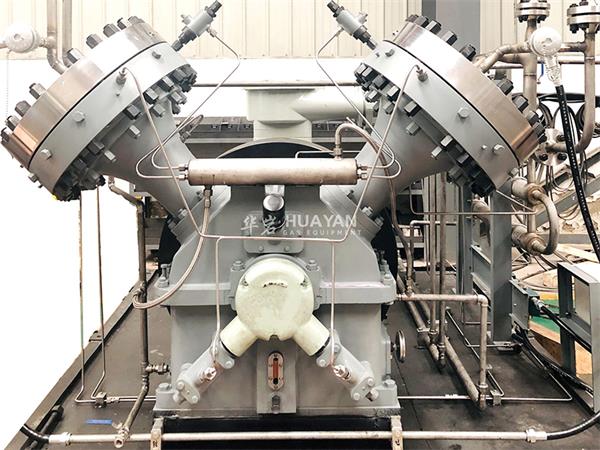The compressor in a hydrogen refueling station is one of the key equipment. The following are common faults and their solutions:
One、 Mechanical malfunction
1. Abnormal vibration of compressor
Cause analysis:
The loosening of the foundation bolts of the compressor leads to unstable foundation and vibration during operation.
The imbalance of rotating components inside the compressor (such as crankshaft, connecting rod, piston, etc.) may be caused by component wear, improper assembly, or foreign objects entering.
The support of the pipeline system is unreasonable or the pipeline stress is too high, causing vibration to be transmitted to the compressor.
Handling method:
Firstly, check the anchor bolts. If they are loose, use a wrench to tighten them to the specified torque. At the same time, check whether the foundation is damaged, and if there is any damage, it should be repaired in a timely manner.
For situations where internal rotating components are unbalanced, it is necessary to shut down and disassemble the compressor for inspection. If it is component wear, such as piston ring wear, a new piston ring should be replaced; If the assembly is improper, it is necessary to reassemble the components correctly; When foreign objects enter, thoroughly clean the internal foreign objects.
Check the support of the pipeline system, add necessary support or adjust the support position to reduce the stress of the pipeline on the compressor. Measures such as shock-absorbing pads can be used to isolate the vibration transmission between the pipeline and the compressor.
2. The compressor makes abnormal noises
Cause analysis:
The moving parts inside the compressor (such as pistons, connecting rods, crankshafts, etc.) are severely worn, and the gaps between them increase, resulting in collision sounds during the movement.
The air valve is damaged, such as the spring of the air valve breaking, the valve plate breaking, etc., which causes abnormal sound during the operation of the air valve.
There are loose components inside the compressor, such as bolts, nuts, etc., which produce vibration sounds during compressor operation.
Handling method:
When there is suspicion of wear on moving parts, it is necessary to shut down the compressor and measure the clearances between each component. If the gap exceeds the specified range, the worn parts should be replaced. For example, when the clearance between the piston and the cylinder is too large, replace the piston or replace the piston after boring the cylinder.
For damaged air valves, the damaged valve should be disassembled and replaced with new valve components. When installing a new air valve, ensure that it is installed correctly and that the opening and closing actions of the valve are flexible.
Check all bolts, nuts, and other fastening components inside the compressor, and tighten any loose parts. If any damage is found to the component, such as bolt slippage, a new component should be replaced.
Two、Lubrication malfunction
1. Lubricating oil pressure is too low
Cause analysis:
Oil pump failure, such as gear wear and motor damage, can cause the oil pump to malfunction and fail to provide sufficient oil pressure.
The oil filter is clogged, and the resistance increases when lubricating oil passes through the oil filter, causing a decrease in oil pressure.
The oil pressure regulating valve is malfunctioning, causing the oil pressure to be unable to be adjusted to the normal range.
Handling method:
Check the working condition of the oil pump. If the oil pump gear is worn, the oil pump needs to be replaced; If the oil pump motor malfunctions, repair or replace the motor.
Clean or replace the oil filter. Regularly maintain the oil filter and decide whether to continue using it after cleaning or replace it with a new one based on the degree of blockage of the filter.
Check the oil pressure regulating valve and repair or replace the faulty regulating valve. At the same time, it is necessary to check whether the oil pressure sensor is accurate to ensure the authenticity of the oil pressure display value.
2. Lubricating oil temperature is too high
Cause analysis:
Malfunctions in the lubricating oil cooling system, such as clogged water pipes in the cooler or malfunctioning cooling fans, can cause the lubricating oil to fail to cool properly.
The excessive load on the compressor leads to excessive heat generated by friction, which in turn increases the temperature of the lubricating oil.
Handling method:
For cooling system failures, if the water pipes of the cooler are blocked, chemical or physical cleaning methods can be used to remove the blockage; When the cooling fan malfunctions, repair or replace the fan. At the same time, check whether the circulation pump of the cooling system is working properly to ensure that the lubricating oil can circulate normally in the cooling system.
When the compressor is overloaded, check the parameters such as intake pressure, exhaust pressure, and flow rate of the compressor, and analyze the reasons for the overload. If it is a process problem during hydrogenation, such as excessive hydrogenation flow, it is necessary to adjust the process parameters and reduce the compressor load.
Three、 Sealing malfunction
Gas leakage
Cause analysis:
The seals of the compressor (such as piston rings, packing boxes, etc.) are worn or damaged, causing gas to leak from the high-pressure side to the low-pressure side.
Impurities or scratches on the sealing surface have damaged the sealing performance.
Handling method:
Check the wear of the seals. If the piston ring is worn, replace it with a new one; For damaged stuffing boxes, replace the stuffing boxes or their sealing materials. After replacing the seal, ensure that it is installed correctly and conduct a leak test.
For situations where there are impurities on the sealing surface, clean the impurities on the sealing surface; If there are scratches, repair or replace the sealing components according to the severity of the scratches. Minor scratches can be repaired by grinding or other methods, while severe scratches require replacement of sealing components.
Post time: Nov-01-2024


